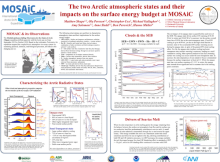The two Arctic atmospheric states and their impacts on the surface energy budget at MOSAiC
Matthew
Shupe
University of Colorado / NOAA-PSL
Poster
Clouds are one of the leading drivers of variability in the Arctic atmosphere-surface system and a major control on the surface energy budget over various cryospheric surfaces. Distributions of surface net longwave radiative flux reveal two distinct radiative states of the atmosphere over sea ice, the radiatively opaque and the optically thin states. Observations from the yearlong Multidisciplinary drifting Observatory for the Study of Arctic Climate (MOSAiC, 2019-2020) expedition provide particular insight into these two states, the cloud and atmospheric properties that comprise them, their variability over an annual cycle, and the implications they have on the partitioning of energy across the atmosphere-surface interface. Observations demonstrate that the optically thick state of the atmosphere consists largely of liquid-containing clouds, but also includes deep layers of cloud ice and snow. The optically thin atmospheric state has little, if any, liquid water, but is typically dominated by cloud-free conditions or layers of cloud ice that have little impact on surface radiation. Atmospheric water vapor also exerts a strong influence on these atmospheric states, largely because it is closely related to the occurrence of clouds. In contrast to some past analyses, there is no clear relationship between atmospheric pressure and the atmospheric states observed at MOSAiC. Given the occurrence of the atmospheric states, the surface energy budget over the sea ice at MOSAiC is partitioned into contributions from each state to demonstrate the cumulative impacts of the states on the annual evolution of sea ice temperature, surface radiation, turbulent heat flux, and conductive flux through the ice and snow. The data are also used to indirectly examine the energetic contributions to summer melt and their attribution to the two atmospheric states, demonstrating the strong influence of clouds on sea ice melt and processes central to Arctic amplification.

shupe-matthew-polar-poster.pdf
(1.08 MB)
